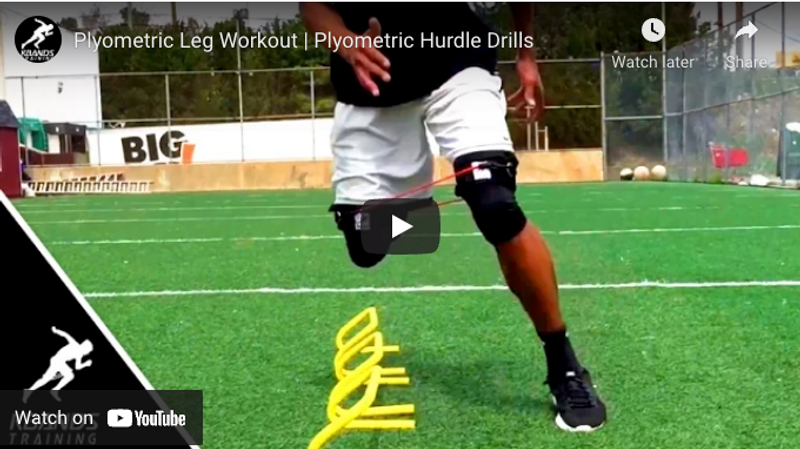Resisted Plyometric Leg Workout
Plyometric leg workouts teach athletes to be quick and powerful when performing explosive movements. Hurdles and hurdle drills can enhance these plyometric leg workouts by adding a visible stimuli which will force the athlete to challenge the height of their jump or explosive movement up and over the hurdles.
The use of Kbands Leg Resistance Bands during plyometric leg workouts will enhance the muscle activation in the thighs and legs while also promoting proper jumping and landing technique as athletes move over the hurdles.
During the Plyometric Hurdle Drills athletes will be jumping laterally over hurdles. With each jump athletes will need to use good jumping form to not only clear each of the hurdles, but to also gain ground and work toward the final sprint out at the end of the hurdle drills.
With each jump over the hurdles athletes will balance and jump off their outside leg. While athletes are loading up for the jump over the hurdles they will want to limit the flexion at their knee and instead focus on increasing the flexion at their hip by lowering their chest. A quick, explosive, and simultaneous extension at the hips and knee will allow the athletes to quickly and smoothly clear the hurdles before landing and stabilizing on their opposite foot. Properly loading the arms will help to increase the momentum of the jump over the hurdles while also increasing the amount of muscle fibers which are activated by the body for the jump. As athletes land on their opposite leg it is important they absorb the impact by flexing at the hips, knees, and ankles. This will also allow the athlete to quickly explode into the next jump.
Three Phase Hurdle Drills
The Plyometric Hurdle Drills progress in intensity and extremity. This progression will allow athletes to be properly warmed up for the more advanced portions of the Plyometric Hurdle Drills, while forcing the athletes to focus on good technique and execution which they can carry over into the more advanced portions of the plyometric leg workout.
The first phase of the Plyometric Hurdle Drills does not require the use of the hurdles, which will be utilized in the final two phases of the Plyometric Hurdle Drills. Athletes will securely attach the Kbands Leg Resistance Bands around the top of their knees and line up in an area with 20-30 yards of open space. Athletes will begin the hurdle drills by jumping backward off of one leg at a 45 degree angle. After the jump, athletes will land on their opposite leg and focus on balancing and sticking the landing. Athletes will push off their plant leg and backward jump at a 45 degree angle landing on their opposite leg. Once athletes land their fourth backward hop they will turn and accelerate into a 10-20 yard sprint.
The following two phases of the Plyometric Hurdle Drills move forward. The backward motion of the initial phase of the plyometric leg workout forces athletes to engage the more balance oriented muscles in the body. This will make for quicker, more efficient jumps while also inducing smoother and softer landings in the later phases of the Plyometric Hurdle Drills.
Athletes will complete 4-5 resisted repetitions of the first phase of the Plyometric Hurdle Drills allowing 40-60 seconds of recovery between sets. Athletes should challenge themselves with the distance of each jump while making the level of resistance used and the distance of the finishing sprint appropriate for the athletes’ age, skill, and conditioning level.
Resisted Hurdle Drills
After completing the non-hurdles portion of the Plyometric Hurdle Drills athletes will place 3-4 shorter hurdles in a straight line while placing 1-2 Speed and Agility Cones 10-20 yards past the end of the hurdles. The Speed and Agility Cones will act as the finishing line for the finishing sprint out.
Athletes will keep their Kbands Leg Resistance Bands attached as they line up at the end of the line of hurdles and laterally jump back and over the hurdles. Athletes will be working for speed on this second phase of the plyometric leg workout as they push off and accelerate into the air with their outside leg, while landing and balancing on their opposite leg. Athletes will continue this alternating leg sequence through the hurdles before finishing the plyometric leg workout with a 10-20 yard sprint out.
Athletes need to remember that they are working for speed as they go over the shorter hurdles. This means that athletes should be actively thinking about exploding over the hurdles, making a smooth and controlled landing, then quickly accelerating back over the hurdles. Complete 4-5 resisted repetitions of this portion of the Plyometric Hurdle Drills before moving into the third and final phase of the plyometric leg workout. Allow 40-60 seconds of rest between sets of the hurdle drills.
Hurdle Drills For Height
The final phase of the Plyometric Hurdle Drills will work much the same way as the previous portion. Athletes will attach their Kbands Leg Resistance Bands just above their knees replacing the shorter hurdles with taller hurdles. Athletes will keep the Speed and Agility Cones at the same distance for the final sprint out.
Taller hurdles will challenge athletes’ explosiveness on the jumping phase while challenging their balance, coordination, and single leg strength on the landing phase of the plyometric leg workout. Athletes will have to place much more focus and emphasis on using proper form and technique to successfully clear the taller hurdles. The tempo for the final phase of the Plyometric Hurdle Drills should be slower with a greater focus placed on clearing the hurdles and successfully landing each jump. Complete 4-5 resisted sets of the final portion of the Plyometric Hurdle Drills allowing 40-60 seconds of rest between sets. If athletes do not have access to higher hurdles then they can use the shorter hurdles while placing extra emphasis on jump height over each of the hurdles.

